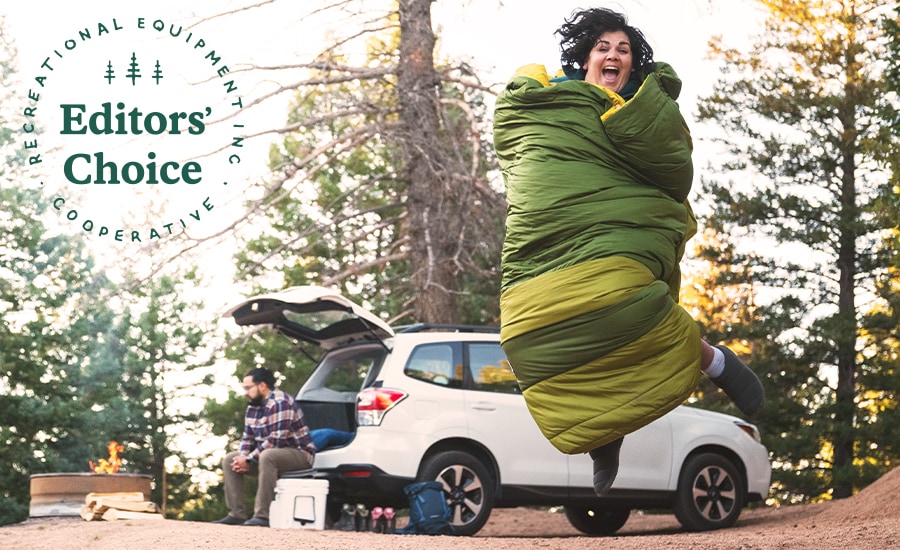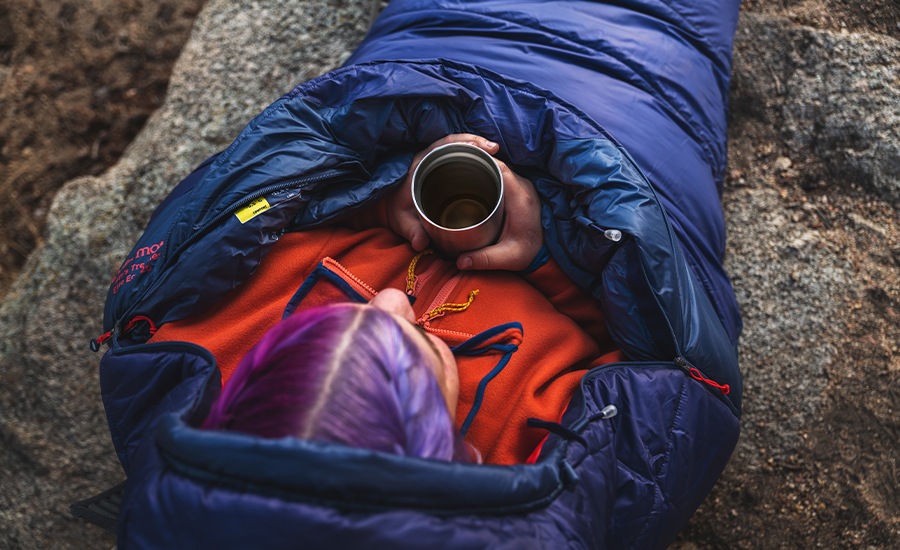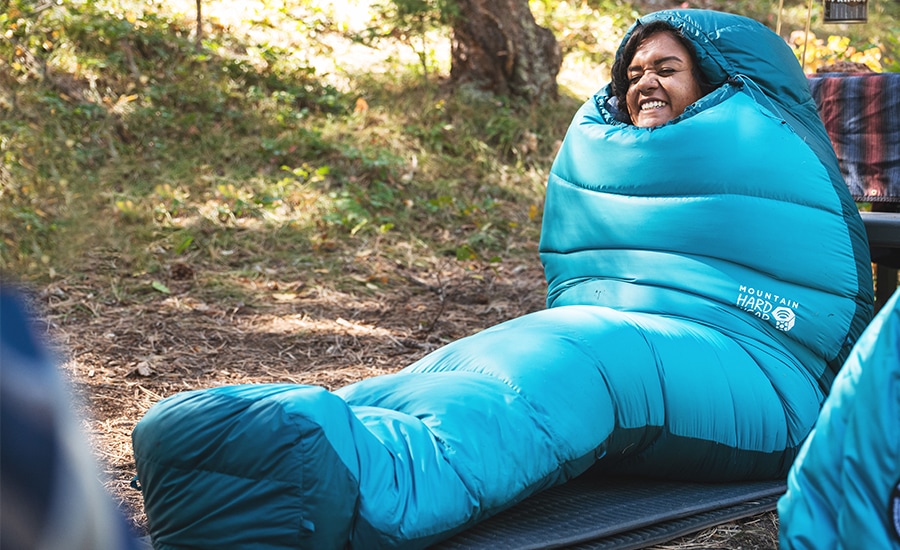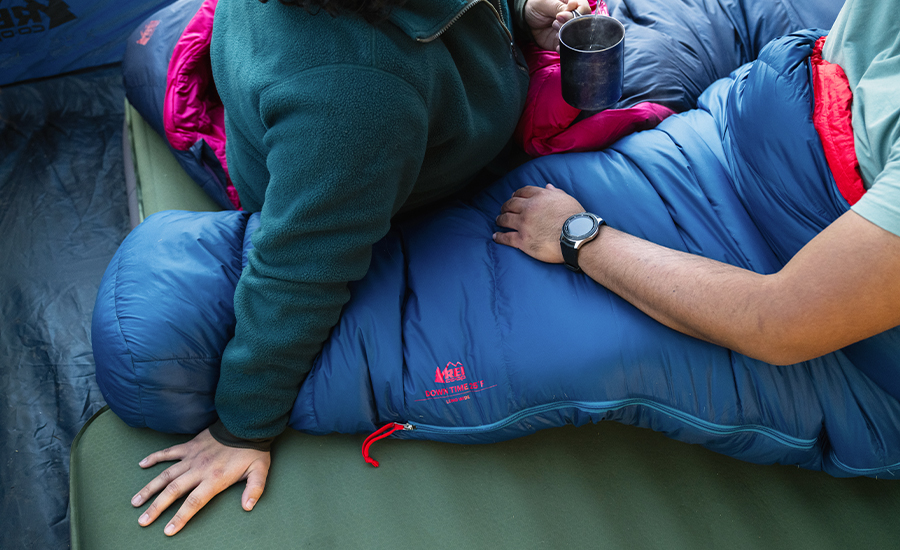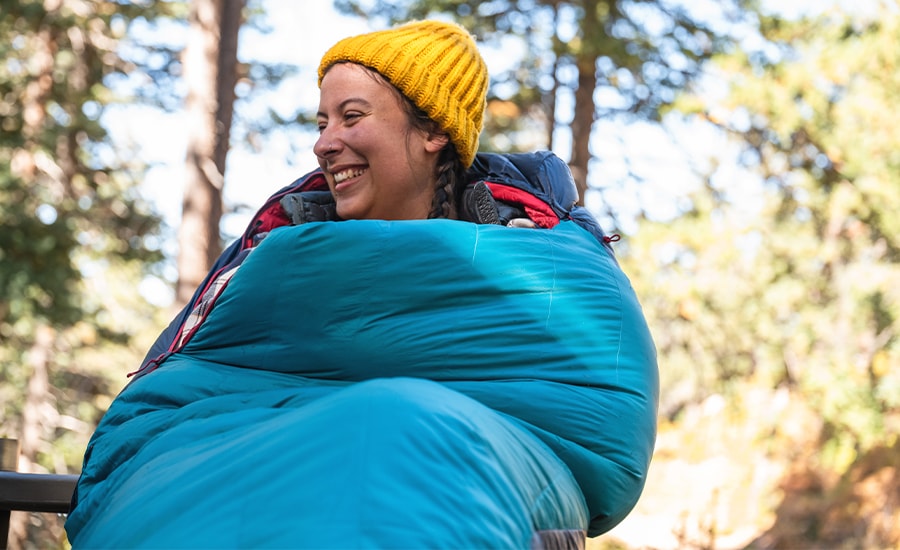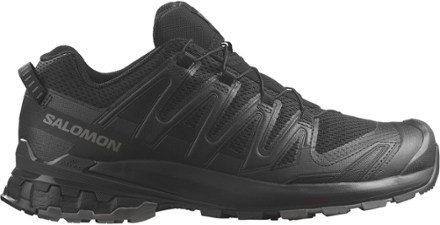You can't take your bedding to the campground, but this nest is the next best thing. The ultraspacious, feature-rich Big Agnes Echo Park 20 is the roomiest bag in our test with a 74-inch hip girth—more than a foot and a half broader than most standard sleep sacks. And thats not the only reason it's a REI Co-op Editors' Choice Award winner. "I don't have to adapt my 2X body to fit in this bag as I have in the past," notes one Montana-based tester. "I have a 40-inch waist, and the Echo Park is still a luxury fit." The circumference around the shoulders in the Echo Park 20 is just as palatial: well over 6 feet around. And thanks to double zippers, which allow entry from either side, you can flip the top down like your comforter at home. "Better than a five-star hotel," affirms one editor.
But the real highlight of the Echo Park 20 is its buffet of features. Unzip either side for easy ventilation on toasty evenings. Or on cool nights, use the two hand pockets in the top corners to pull the bag snug around you like a cocoon. Sneak a pillow (or get creative with unused layers) into a specific sleeve in the hood to secure a cushion beneath your head that won't slip out in the night. Another sleeve on the bottom of the Echo Park 20 secures a sleeping pad (up to 30 inches wide) so you won't side off your mat. "If I could give the features an 11 out of 10, I would," says another tester. "Everything makes sense. It's such an intuitive design."
More than two and a half pounds of synthetic insulation in the Echo Park 20 should keep most sleepers warm on three-season pursuits, but it all adds up. The dimensions and multitude of features of this sleeping bag mean it isn't all that light or packable. (One tester grumbled that the sleeping bag couldn't fit in his motorcycle paniers, even when packed away in its included 20-inch stuff sack.) But that's the trade-off for lavish living. Buy here.
"I finally feel like I fit in," announced one punny Virginia-based tester after a season in the Trestles Elite Eco 20. "That sounds superficial, but this bag gives me lightweight and efficient equipment like my smaller friends have." With the Trestles Elite, Marmot maintains a traditional mummy shape (tapering at the feet) to cut bulk and weight but expands the dimensions that matter: shoulder and hip circumference. So even though it packs small (about the size of a gallon of milk) and weighs just 3 pounds, this sleep sack features enough interior space for a 2X camper.
This year's Trestles is a completely different animal from its predecessor—it's a lean, clean, sleeping machine. Marmot uses a new HL-ElixR™ Micro synthetic insulation, which slashes the weight by almost a full pound. It's cleaner because the bag's synthetic fill, unlike the previous stuff, is made using fibers that are made up of 96 percent recycled materials. Another upgrade this year is the softer ripstop polyester lining (and shell) material—"it's softer than butter," says one tester—which is made using 20 percent recycled materials.
Camping pros know that synthetic insulation tends to be heavier and bulkier than down (learn more here), but what it lacks in loft it makes up for in water-resistance and a friendlier price. You don't need to drop a bunch of C-notes on the Trestles Elite Eco 20; at $179, it's one of the most affordable bags in test. That's a heckuva bargain for a sleep sack that's also one of the greenest here. Buy here.
Looking for a bag that you can continue using when the snow starts flying? The Mountain Hardwear Bishop Pass 15 may be your sleep sack. Heaps of down and a more tapered mummy shape that eliminates dead space around the legs and feet should keep campers toasty in subfreezing temps. "The lake froze overnight, and I found crystallized condensation on my tent walls in the morning, but my toes were still warm in this sleeping bag," reported one Colorado tester after a shoulder-season trip in the Gore Range. A full-length draft tube runs the length of the zipper, which minimizes colds spots and maximizes coziness.
Packability is tops in this guide. Even in wide sizes, the Bishop Pass 15 squeezes down to cantaloupe size and weighs less than 3 pounds. Paired with a warm pad, it creates a winter-friendly sleep system that's easily swallowed by overnight backpacks.
Still, that furnace-like warmth and top-tier packability come with a caveat: It's tight living. The 68-inch (women's) or 70-inch (men's) shoulder circumference is about half a foot wider than in a standard-size bag, but the hip girth is roughly normal. Buy here.
The Down Time 25 may be the most-well-rounded bag in our test. It's warm enough for three-season use. It packs small enough for backpacking. It features a host of sustainability attributes. And on top of all that, it showcases premium down insulation. So for folks who want the real stuff, the do-it-all Down Time 25 from REI Co-op may be the best option here.
More than a pound (1 lb. 6 oz. in the long wide size) of duck down insulation fills extra-tall horizontal baffles, giving the insulation plenty of room to loft. "It's the fluffiest bag I've ever used, and it only takes about a minute to puff up after being crammed inside the compression sack," one tester says. Designers opted for synthetic fill in the footbox, where polyester's durability and natural water-resistance would be beneficial if, say, the bag repeatedly rubbed up against a wet tent wall.
In the long wide size, the Down Time 25 comes in about half a foot broader around the hips than a traditional mummy bag. "It was just enough space around my middle to keep me warm without a lot of dead air," noted an XL tester after a chilly 26°F night in Idaho's City of Rocks. A draft collar and full-length draft tube along the zipper help seal out cold air.
Another feature our testers lauded? The price. Premium materials (and a greener manufacturing process) tend to hike up the cost, but the Down Time 25 stays just under $200. And it's the only sleep sack in our test that doesn't cost more for the expanded sizing. Buy here.
The best sleeping bag for you will be relative to how much you otherwise like to rough it outdoors. And if that means staying warm and cozy no matter how far you are from the trailhead, you may want to start adjusting your budget to make room for the Big Agnes Anvil Horn 15, the best wide bag in test.
The Anvil Horn 15 serves up supernova warmth, thanks to premium 650-fill-power down and a generous, semi-rectangular cut that better mimics your bed at home than the tight confines of a typical mummy bag. Like the other Big Agnes bag in this lineup, the Anvil Horn 15 boasts the sort of creature comforts that make sleeping inside it a pleasure: a puffy collar that prevents drafts and sleeves for a pillow and pad (up to 30 inches wide). Its jacket-like hood allows campers to easily wear the bag while sitting up so warmth may never be sacrificed, even for mundane tent chores.
But even with all the bells and whistles, the Anvil Horn 15 still packs down to the size of a watermelon—small enough to fit inside the sleeping-bag compartment of most overnight packs. It weighs merely 3 pounds (and an ounce), so you can tote it on faraway missions if you pair it with a lightweight backpacking mat. That's quite an achievement for a sleep sack with some of the most generous dimensions in test: It's 80 inches around the shoulders and 71 around the hips. (It's comparable to the Echo Park 20, but a touch tighter around the middle—and nearly 2 pounds lighter.)
Of course, no bag is perfect. You won't find recycled materials in the Anvil Horn 15, and, to be frank, luxury is expensive. Buy here.
* The Anvil Horn 15 is available in a women's version (called the Daisy Mae 15), but only the men's (or unisex) has a long wide size option. We did not test the women's regular in this round robin.
Buying Advice
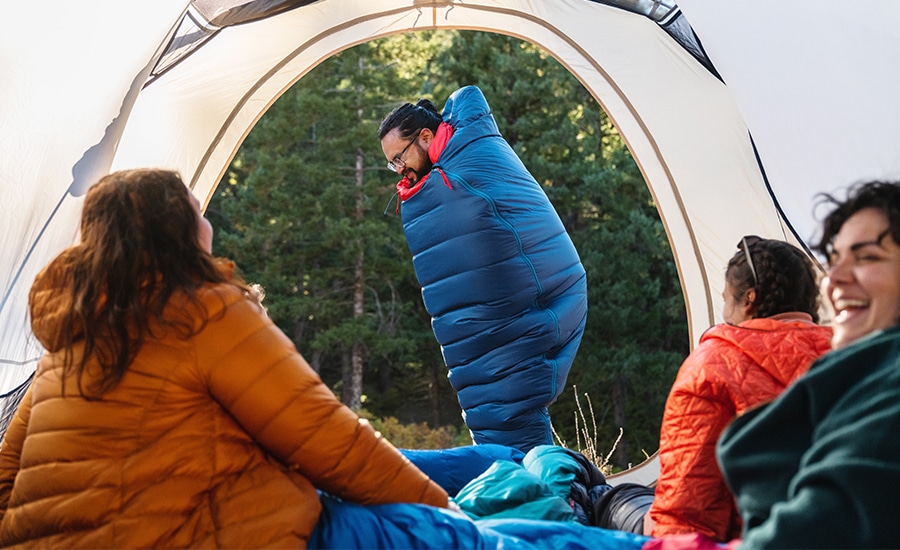
A quality sleeping bag can make or break your next camping adventure, but it may feel daunting if you don't understand what to look for before making your choice. Here are a few factors to consider when snagging yourself a sleeping bag, regardless of its price tag.
Weight and Size
When it comes to car camping, you can simply pick the warmest, roomiest sleeping bag you like because you won't be shouldering it. For a rundown on all the things to consider, read How to Choose Sleeping Bags for Camping.
For backpacking, however, you'll want the warmest, roomiest sleeping bag that fits inside your pack and doesn't weigh you down. You can of course tote however much weight you'd like backpacking, but in this guide, the Marmot Trestles Elite Eco 20, Mountain Hardwear Bishop Pass 15, REI Co-op Down Time 25 and Big Agnes Anvil Horn 15 are the best for it. They're lighter and a bit more compact than the Big Agnes Echo Park 20.
Note that some sleeping bags have a men's or unisex version and a women's version. Though this is how the brand has distinguished them, a more helpful delineation is to think of them as "warm sleeper's" and "cold sleeper's."
Warm sleeper's bags (or men's or unisex) have bigger dimensions and more forgiving temperature ratings. Cold sleeper's bags (or women's) have smaller dimensions and warmer temperature ratings thanks to added insulation. That often makes the cold sleeper's version of the bag heavier and bulkier, despite its smaller dimensions.
Wide Sizes
The sleeping bags in this guide are all available in wide sizes to accommodate more folks. If you're looking for a sleeping bag available in inclusive-size options, consider two dimensions: the circumferences around the shoulders and the hips (both are posted in the specs for each review here).
In a traditional mummy (or tapered) sleeping bag, a standard shoulder girth is between 60 and 64 inches while the hip girth is typically in the ballpark of 58 inches. The sleeping bags in this lineup are each broader. The best way to find a perfect fit for you is to go into a store and try some out, but you can always estimate your dimensions at home with a tape measure.
A third measure—length—should also be considered, particularly if you're taller than 6 feet. Most standard-size sleeping bags are 72 inches long, but many are available in longer dimensions. Typically called "long," these varieties are often 6 inches longer.
Wide sizes tend to also be long—wider at the shoulder and hips, plus 6 inches longer.
Cold sleeper's bags (or women's) are rarely available in wide or long dimensions.
Type of Insulation
Sleeping bags are filled with either down insulation or synthetic insulation. In general, down insulation (made from goose or duck plumage) is lighter and more packable, offering the best warmth to weight. Down isn't inherently water-resistant, but today, most is treated to make it hydrophobic. Down insulation is also very durable and will likely hold up to years of packing and unpacking it into a stuff sack. Trade-off: It tends to cost more than synthetic.
The Mountain Hardwear Bishop Pass 15, REI Co-op Down Time 25 and Big Agnes Anvil Horn 15 use down insulation.
Note: If you opt for a down sleeping bag, be sure to check out the ethical practices of the company making your sleeping bag. These days, most outdoor brands have standards that protect the welfare of the animals, but it's a good idea to be informed.
On the flipside, synthetic insulation (like polyester) retains more warmth when wet, making it a popular choice with folks who live in moist climates. It also dries faster than down and is less likely to aggravate allergies. As an added bonus, it is almost always cheaper than down, too. Synthetic insulation is bulkier than down, however, and often comes with a weight penalty.
The Big Agnes Echo Park 20 and Marmot Trestles Elite Eco 20 are made with synthetic insulation.
Shape
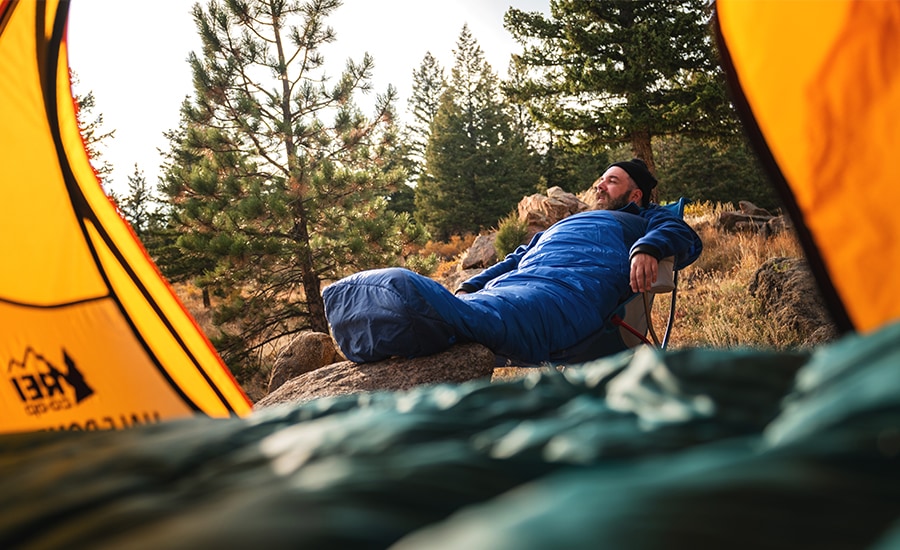
In this guide, you'll see two shapes of sleeping bags: mummy and semi-rectangular.
A mummy is wider in the shoulders before tapering at the knees and footbox. This eliminates extra space inside the sleeping bag, making it easier to create and maintain warmth. It also cuts down on materials and weight, which makes this style popular in the backpacking and ultralight communities.
If it fits, a mummy bag will provide the most efficient warmth. The mummies in this lineup are the Marmot Trestles Elite Eco 20 (pictured above), Mountain Hardwear Bishop Pass 15 and REI Co-op Down Time 25.
A rectangular sleeping bag looks just like it sounds: a large rectangle. The bag does not taper like a mummy bag does and instead maintains its shape to give campers maximum wiggle room. However, this shape does mean there is more dead space in the bag, making it tougher to stay warm.
That's why some brands, like Big Agnes, have gravitated toward what's called a semi-rectangular shape. This style of sleeping bag cashes in on the comfort of a traditional rectangular bag while cutting some corners (literally) to save an iota of space and weight.
The Big Agnes Echo Park 20 and Anvil Horn 15 are semi-rectangular.
Temperature Rating
We could pen a thesis on how temperature ratings are determined, but for you, dear reader, all you need to know is that the number in the name of the sleeping bag is pretty close to what its lower limit is. So our most basic advice is to purchase a sleeping bag with a number that's 10°F to 15°F lower than what you expect to encounter on your coldest trips. (Err on the side of going too warm because you can always unzip your bag or kick a leg out.) For example, if you do most of your camping in the mountains where temperature drop into the 30s at night, go for a bag that has 20 in the name.
In general, summer-season camping calls for bags rated to 30°F or higher. Three-season camping (which includes shoulder seasons) usually requires bags with ratings closer to 20°F. You won't find anything that much warmer for less than $200 on the market (the warmer the bag, the more it costs, generally).
Of course, choosing a temperature rating is an exercise in knowing yourself, too. If you're a person who is always cold, take that into consideration.
Temperature Ratings, Explained
Remember that thesis? It would go something like this.
Being able to compare one brand's 20°F bag against another's used to be a problem because outdoor brands tested them differently. Decades of work to standardize those ratings thankfully means nearly all brands play by the same rules now, though those rules are complicated.
An "ISO" or "EN" temperature rating indicates the test standard used. Either requires rigorous, standardized testing and the two standards are roughly comparable. So, as long as a bag has one of those acronyms, you can compare their temperature ratings. Read Understanding Sleeping Bag Temperature Ratings to learn more.
Note that, while these test standards can be applied to most backpacking bags, certain sleeping bags are not covered by the standards and are assigned temperature ratings by varying tests used by the brand.
Bags are assigned two temperature ratings: limit and comfort ratings. Lower-limit rating is the lowest temperature at which the bag will keep a warm sleeper comfortable and is generally the temperature assigned to men's or unisex bags. Comfort rating is the lowest temperature at which the bag will keep the average cold sleeper comfortable and is generally the temperature assigned to women-specific bags. If a temperature rating omits the term "comfort" or "limit," then it's likely a brand's estimate, not an ISO or EN test result.
Cold sleeper's (women's) bags that use the warmer "comfort rating" as their standard will inevitably be heavier than the equivalent warm sleeper's (men's) bags. It simply requires more of a given insulation to achieve more warmth.
A temperature rating is not a guarantee of warmth. Standardized ratings are super important because you can more reliably compare bags from different brands. But metabolisms vary greatly from person to person, as do variables like the pad you pair your bag with, humidity, wind, type of shelter, ground conditions, clothing and personal preferences.
Methodology
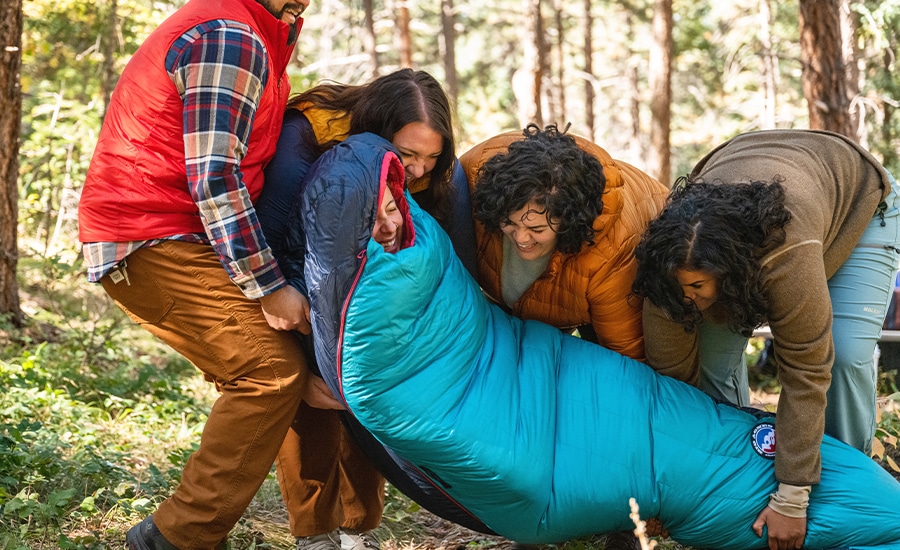
In 2021, we asked 11 co-op members from around the country to put pillow to dirt in an effort to test the best inclusive-size sleeping bags available at REI Co-op. Our testers ranged in size from XL to 4X. During the testing months, they frolicked through alpine meadows, endured unseasonable snow, hunkered down in wind and picked grit from their teeth during canyon-country epics—all in an effort to bring the best feedback and testing notes.
These co-op member-testers evaluated each sleeping bag on its warmth, comfort, size, durability, packability and features, also taking sustainability attributes and price into account. We combined their ratings and took the average to find the overall scores listed here. The five sleeping bags in this guide earned the highest scores in our round-robin; the Big Agnes Echo Park 20 was the top overall performer. It has been commemorated with an REI Co-op Editors' Choice Award.

